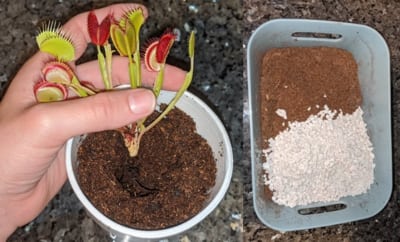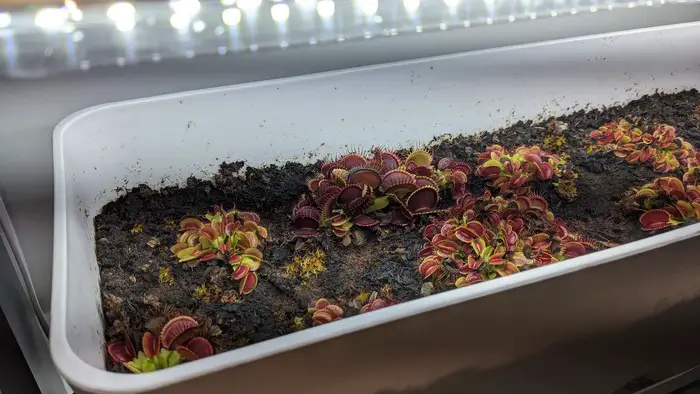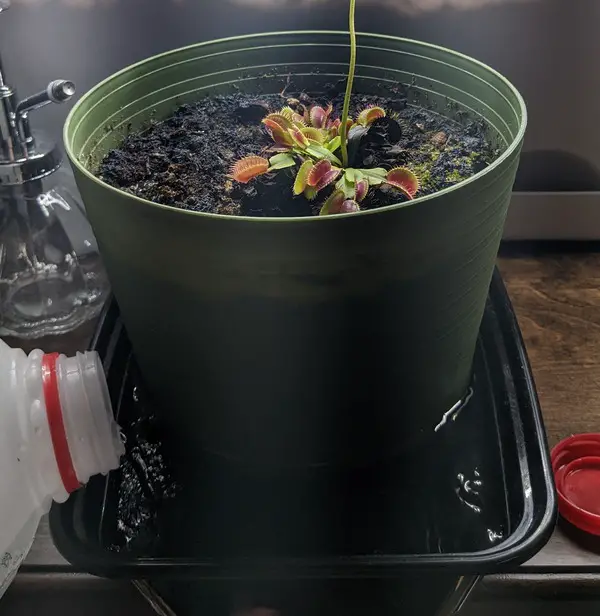Growing Venus fly traps successfully is different from growing most house plants. I have grown Venus fly traps for over 5 years and can tell you it is not extremely hard, but it does require you to follow some very unique instructions.
In this blog you will learn step by step how to keep your Venus fly trap healthy and most importantly, alive 😉
Select the carnivorous plant soil for your Venus fly trap
Venus fly traps require an specific type of soil to survive.
In the wild, they live in very poor conditions, with ground that lacks all the nutrients. For that reason, they have developed an intolerance to standard nutrients and fertilizers.
Potting your Venus fly traps in standard potting soil like Miracle Grow will kill your plant. Most cactus soil, succulent soil, garden bed soil, or even potting soil is jam packed with fertilizers and additives (which are great for most plants) that can herm Venus fly traps.
Venus fly traps required nutrient-free soil to stay alive. Carnivorous plant soil mixes are a common solution. These mixes are made up of pure peat moss or long fiber sphagnum moss with silica sand or perlite. All of the ingredients must be pure, without any additives.
You can buy moss and perlite or sand in your gardening store, you just need to make sure it is nutrient-free version. Also, you can buy carnivorous plant soil online.
You can also buy already made carnivorous plant soil. With this strategy, you ensure the medium is appropriate.
Do a quick search for carnivorous plant soil and you will find many options online. Just keep an eye on the reviews to verify the authenticity. A quart of carnivorous plant soil costs on $5-10 a quart.
This is an example of an affordable and effective carnivorous plant soil mix I personally use. It usually costs less than 10 dollars for a quart. Follow the link to confirm the price on Amazon.com.
I personally use. It usually costs less than 10 dollars for a quart. Follow the link to confirm the price on Amazon.com.
This article teaches you how to make your own soil and how to pot your plant: Soil and Potting for Venus fly traps .
.

Besides choosing the appropriate soil, pay attention to the pot you use. Some materials leach minerals into the ground. Here are my Venus fly trap pot recommendations .
.
Get distilled, RO or rain water for watering
Venus fly traps are very sensitives to minerals in the water they consume.
For optimal result use distilled water, never osmosis water or rainwater for Venus flytraps. Those three options are completely safe for Venus fly traps. Avoid tap water and bottled water as it usually contains a high amount of minerals and electrolytes that are harmful for carnivorous plants.
The easiest way to find the appropriate water is to buy distilled water in the grocery store, not all chains carry it, but the majority of larger stores do sell distilled water in jugs of a gallon for less than $1.5.
If you are in the US, Walmart, Kroger, Fry’s and the vast majority of groceries will carry distilled water.
Filtered water can also appropriate for a Venus fly trap, depending on what water filter you use. I have tried a few, and the only one that met the specs was Zero water. Zero Water filters remove all particles from the water, which is optimal for carnivorous plants.
You check out the specs and price of the zero-water filter here (the link will take you to Amazon.com). I have used it successfully for my plants for years (change the filter every few months 🙂 )
(the link will take you to Amazon.com). I have used it successfully for my plants for years (change the filter every few months 🙂 )
Sometimes tao water or bottled water are within the acceptable range for Venus fly traps, but you will have to test the mineral content. This article teaches you how to asses your water for carnivorous plant use.
Place your Venus flytrap in a bright location with at least six hours of direct sunlight
Not providing enough lighting is one of the most common mistakes for new Venus fly trap owners.
Venus fly traps thrive in sunny locations.
Optimally, a Venus fly trap should grow under over 10 daily hours of direct sunlights. They can survive with 4-6 hour of direct sunlight, if the brightness is sufficient, but they will thrive in extremely sunny locations.
If you just got your plant from a shop, introduce it to sunlight slowly.
First to a couple of hours, ad a couple of hours after a few days. And slowly transition into the full 10 plus hours. Do not be afraid of placing your plant under full sunlight.
Venus fly traps thrive in sunny weather.
Here is a complete guide on lighting . Mastering is key to keep your plant healthy.
. Mastering is key to keep your plant healthy.
Growing Venus fly traps indoors is also possible. However, the lighting is a lot more challenging.
Do your best to find a location with sunlight, maybe a sunny windowsill. You can use artificial lights if sunlight is not enough.
When employing artificial lights for Venus fly traps, choose LED or fluorescent lights of at least 1500 lumens and 6500K. Place the artificial lights 10-12 inches from the Venus fly traps and run the lights for 10-16 hours a day.
Selecting the most appropriate indoor light for Venus fly traps can be difficult. And getting it wrong can kill your plant.

These lights have helped me provide lighting for two of my plants when I first got started. Eventually, I switched to a larger lighting setup, but this light is perfect if you are just getting started or just have a few plants.
have helped me provide lighting for two of my plants when I first got started. Eventually, I switched to a larger lighting setup, but this light is perfect if you are just getting started or just have a few plants.
Also, this article can help you select an appropriate light for your plant, with lot’s of options.
Master the watering frequency to keep the soil moist at all times
Venus fly traps are great plants in terms of watering. They are extremely hard to overwater.
Water Venus fly traps every 2-5 days to keep them alive. The soil of a Venus fly trap must be humid at all times. Still, you should avoid flooding the soil, it must be humid, but not damped.
Venus fly traps love humid locations. I water my plants every few days and use this easy trick to ensure I am not under or overwatering. touch the soil after watering. the soil should be overall humid, not flooded (muddy consistency) or half dry.
I recommend using the water tray method to water your plant effectively every single time. Place your pot in a twater tray. Add water to the tray, usually 1-2 inched of water is enough. This will keep the soil humid by watering from the bottom.
The plant will consume the water. Do not add more water until the tray dries out. Once it is dry. Refill with a couple of inches of water. This method is gold to keep the watering to the perfect amount.

Select a tall plastic or glazed ceramic pot for your Venus flytrap
Some pots are made of materials that leach minerals to the ground. Those minerals are harmful for Venus fly traps, For that reason you should avoid unglazed ceramic, metal, and terra cotta pots.
Venus fly traps thrive in 5-inch tall plastic or glazed ceramic pots. Plastic and glazed ceramic pots do not leach minerals to the ground and provide great insulation.
Personally, I buy white pots for my plants growing outdoors. it helps control the heat.
Here is an example of pots that are great for Venus flytraps: https://amzn.to/3IYVGKU .
.
Learn how to feed your plant to keep it healthy
Venus fly traps capture insects to gather key nutrients they can’t find in the soil.
If you own a Venus fly trap, there is no need to feed it. Plants growing outdoors capture their own bugs.
Also, the nutrients they extract are just a supplement to their diet. You do not need to feed your plant at all at it will stay alive. However, feeding your plant can provide benefits like expedited growth.
Feed your Venus fly trap by providing a single insect every 2 to 6 weeks. A single bug has enough nutrients for the whole plant. The size of the insect is very important. Select a bug that is 1/3 of the size of the trap or smaller.
And at all costs, do NOT use human food to feed your plant. This article has a complete list of what you should and shouldn’t feed a Venus fly trap.
If you are new to Venus fly traps, this article is a step by step guide of the feeding process . Doing it incorrectly won’t kill your plant, but can cause it to be unhealthy.
. Doing it incorrectly won’t kill your plant, but can cause it to be unhealthy.
Avoid any type of fertilizers
Venus fly traps suffer greatly when exposed to nutrients in the soil or the water.
Fertilizing Venus fly traps can kill them very quickly.
the only type of fertilizers they can withstand is Maxsea, but in a diluted form and only in the leaves.
If you are a beginner grower, forget about fertilizing your plants. It is not necessary and it can be harmful if you don’t do it right. instead, feed your plant, that should provide more than enough nutrients.
Remove any stress from the environment
Venus fly traps can turn black and lose leaves when they encounter stress. Stress won’t kill your plant right away, but can be a debilitating factor.
Here are some tips to avoid causing stress to your plant:
- Do not trigger the traps of your plant unless you are feeding it
- Repot your plant once a year, more is unnecessary
- Avoid constantly changing the location of your plant and take your time to acclimate your fly trap
- Place your plant in a quiet location where pets and humans are not constantly poking it
Learn about the winter dormancy and apply it
Venus flytraps live through winters every year in the wild. When the temperature drops Venus flytraps go dormant (similar to hibernation).
Dormancy is key for Venus fly traps to stay alive for years.
Venus flytraps must go dormant for 3 to 4 months, every year. If they do not experience this period of inactivity the plant will die. Venus flytraps go dormant when they experience cold weather of less than 45F (7C) for a minimum of three months. There are methods to achieve dormancy indoors and outdoors.
If properly taken care of Venus fly traps can live for about 20 years. Dormancy is a requirement to keep them healthy for that long.
This article can walk you though the details of how dormancy work’s and how to achieve it.
Recommended Products for Growing Carnivorous Plants
Finding the best pots, lights, and soil for carnivorous plants is difficult. I have grown carnivorous plants for over 5 years, and these are the products I use. The links will take you to Amazon to view the prices and full specs:
- Carnivorous Plant Soil
- Carnivorous plant soil: https://amzn.to/422yLZa

- Carnivorous plant soil: https://amzn.to/422yLZa
- Artificial Lighting
- Small plant light for 1-2 plants: https://amzn.to/3oQsmSj

- T8 LED light fixture for multiple plants (6500k Cool White): https://amzn.to/3uWoeh2

- Small plant light for 1-2 plants: https://amzn.to/3oQsmSj
- Pots and Miscellaneus
- Nursery pots for single plants: https://amzn.to/3oL8YGq

- Nursery pots for single plants: https://amzn.to/3oL8YGq
- TDS meter to measure water quality: https://amzn.to/3g8VKLI

- Dried crickets to feed carnivorous plants: https://amzn.to/34QEnKv

